History of Ann Agatha Walker
By Marie Dean Speakman (great-great grandaughter)
Ancestry & Early Life
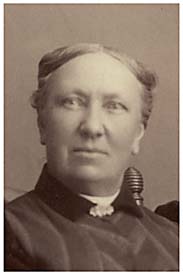 Ann
Agatha Walker was born June 11, 1829, on Derby Street, in Leek, Staffordshire,
England. Her father, William Gibson Walker, was born 7 July 1796 at Leek, Staffordshire,
England, a son of James Walker and Elizabeth Gibson. Ann Agatha’s mother was
Mary Goodwin, born 8 July 1798, also in Leeks, a daughter of William Goodwin
and Hannah Booth. Ann Agatha was the eldest of six children.
Ann
Agatha Walker was born June 11, 1829, on Derby Street, in Leek, Staffordshire,
England. Her father, William Gibson Walker, was born 7 July 1796 at Leek, Staffordshire,
England, a son of James Walker and Elizabeth Gibson. Ann Agatha’s mother was
Mary Goodwin, born 8 July 1798, also in Leeks, a daughter of William Goodwin
and Hannah Booth. Ann Agatha was the eldest of six children.
William Gibson Walker was a schoolteacher, and Mary Goodwin Walker was the town milliner. They belonged to the Wesleyan Methodist Church and were deeply religious. Ann Agatha remembered that her mother often gathered her little ones around her and told them Bible stories.
The death dates of Ann Agatha’s parents were: William Gibson Walker, 11 March 1875, in Salt Lake City, Utah. Mary Goodwin Walker died 15 August 1851 at St. Louis, Missouri.
Converts to The New Religion
When Ann Agatha was eight years old, it was the year of Queen Victoria’s coronation and “the new gospel was brought to England.” The Walker family moved to Manchester and Ann Agatha attended the school where her father taught. Six years later, they moved to Pendleton where William held an office in the Wesleyan Methodist Church and was a local preacher. Mormon missionaries were there in Pendleton, and William became interested in the Church. He started attending their meetings, but sat where he couldn’t be seen because of the office he held in his own religion. A few weeks later, he and his family were all baptized at the same time, except his daughter, Dorcas. William was ordained an elder at the water’s edge and was immediately sent to labor in the ministry of the gospel.
Journey to America on the America
It was the desire of all to come to Zion and join the Saints. When Elders Parley P. Pratt and John Taylor and others completed their mission, Ann Agatha was the one from her family to return with them to America. She was seventeen at this time. The group sailed from Liverpool in the new ship, America, January 19, 1847. After nine days of severe weather, they sailed back to Liverpool and, on January 29th, the journey was started again. It took thirty-five days to reach New Orleans where they were delayed a couple of days by fog before they could enter the port. They traveled on a Mississippi river boat to St. Joseph, Missouri.
Wedding & the Trek West
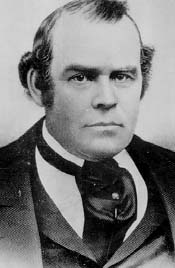 They
met Elder Pratt again when he arrived in Winter Quarters about April 8th. It
was here that Ann Agatha married Parley P. Pratt on April 28, 1847. They were
married by Apostle John Taylor. She was his tenth wife and they became the parents
of five children.
They
met Elder Pratt again when he arrived in Winter Quarters about April 8th. It
was here that Ann Agatha married Parley P. Pratt on April 28, 1847. They were
married by Apostle John Taylor. She was his tenth wife and they became the parents
of five children.
In her journal, Ann Agatha records: “My wedding day was April 28, 1847. I married Brother Parley P. Pratt (right), an Apostle in the Latter-day Saint church—a very fine man, a true and loving husband always. My husband, being in charge of the company, was extremely busy mending wagons, looking up yoke-bows, making boy-keys, or pins to hold the bows in the yokes, hunting up the cattle, mating them, finding chains, especially lock-chains, for bear in mind there were no brakes to hold wagons back when going down steep hills in those days. These and a hundred other things occupied his time. Meanwhile we were busy making and mending wagon covers, and in every way aiding and assisting to prepare for the long and toilsome journey. “To aid him, two of us women, which included Belinda Marden Pratt, sixth wife of Parley P. Pratt, and I, thought we would manage without his help to drive our own team, which consisted of a yoke of oxen. Belinda’s (1 year old) son, Nephi, accompanied us. At last we started and got as far as the Elk Horn River, early in June, where we camped about a month waiting for the rest to arrive, so as to organize into companies of hundreds, fifties, and tens.
“About July fourth we moved up the Platte River— now we were truly on the trek west. The brethren made a large and substantial raft on which to ferry us across. The cattle were made to swim over. Coming from a large city and not being used to this kind of life, never having seen cattle yoked together even, still I thought, “Well, what any other woman can do, I can do.” So shouldering my whip, I drove out of Winter Quarters and soon learned to manage my team first class.”
(Ann Agatha recorded many faith promoting experiences and many trials — her journal is most Interesting.)
Arrival in the City of the Great Salt Lake
Ann Agatha tells of their arrival in the Valley September 28, 1847. She recorded, “When my eyes rested on the beautiful entrancing sight—the Valley—oh! How my heart swelled within me. I could have laughed and cried; such a commingling of emotions I cannot describe. My soul was filled with thankfulness to God for bringing us to a place of rest and safety—a home.”
Ann Agatha’s shoes were worn out when they arrived in the Valley. Of course, no shoes were available anywhere, but she was able to trade a necktie she had for a piece of buckskin a lady had bought from the Indians, and made herself a pair of moccasins.
Marauding Crickets
Ann Agatha tells of getting settled in the valley, the shortage of supplies the first winter, the planting and tending of crops. She tells of the cricket invading their wheat “It was a sickening sight—every stalk was bowed down by large crickets. Parley said. ‘Here is our wheat covered with devouring crickets. We are a thousand miles from supplies. Unless God interposes, starvation stares us in the face.’ Yet even in this great strait, not even a doubt entered our minds, for we firmly believed in and trusted God, who had kept and preserved us hitherto.” She then tells how the gulls came, gorged themselves with the crickets, flew to the lake, disgorged themselves, came back again till the plague was stayed, “and we harvested more wheat to the acre than seemed possible under the circumstances, for we had not then learned to irrigate.”
Firstborn Babe & Harvest Celebration
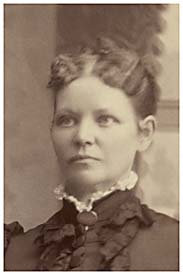 The
first child of Parley and Ann Agatha was Agatha (photo - right), born 7 July
1848 on Pioneer Square. Ann Agatha tells that she “had scarcely a full enjoyable
meal through the nine months previous to the birth of my babe, yet she was a
plump, healthy child. On Monday, (the tenth of July) my husband went early
in the morning, sickle in hand, cut a little wheat here and there where it had
ripened, threshed it with flail and wagon cover, and took it on his shoulder
to Brother Neff’s mill, had it ground, brought it home, had a big loaf baked
in a bake kettle, and the whole family sat down to dinner in the room where
I was, so that I might enjoy it with them. Just think what a feast! On the
tenth of August, we had what we called our Harvest Feast. The brethren built
a bowery and stand and raised a liberty
pole, on which was corn eight
feet high, large sheaves of wheat, oats, barley, rye and other products for
exhibition. We feasted on the good things we had raised. We had music, songs
of praise, prayer and thanksgiving, congratulations, speeches, recitations,
and dancing, but the most grand and impressive of all to me was the great and
united shout of Hosanna, Hosanna, Hosanna! To God and the Lamb. It surely was
a shout of heartfelt praise and thanks to God. Scarcely a year had elapsed since
we had arrived here in an almost starving condition and now we had plenty to
eat.”
The
first child of Parley and Ann Agatha was Agatha (photo - right), born 7 July
1848 on Pioneer Square. Ann Agatha tells that she “had scarcely a full enjoyable
meal through the nine months previous to the birth of my babe, yet she was a
plump, healthy child. On Monday, (the tenth of July) my husband went early
in the morning, sickle in hand, cut a little wheat here and there where it had
ripened, threshed it with flail and wagon cover, and took it on his shoulder
to Brother Neff’s mill, had it ground, brought it home, had a big loaf baked
in a bake kettle, and the whole family sat down to dinner in the room where
I was, so that I might enjoy it with them. Just think what a feast! On the
tenth of August, we had what we called our Harvest Feast. The brethren built
a bowery and stand and raised a liberty
pole, on which was corn eight
feet high, large sheaves of wheat, oats, barley, rye and other products for
exhibition. We feasted on the good things we had raised. We had music, songs
of praise, prayer and thanksgiving, congratulations, speeches, recitations,
and dancing, but the most grand and impressive of all to me was the great and
united shout of Hosanna, Hosanna, Hosanna! To God and the Lamb. It surely was
a shout of heartfelt praise and thanks to God. Scarcely a year had elapsed since
we had arrived here in an almost starving condition and now we had plenty to
eat.”
Ann Agatha’s Remarks on Plural Marriage
Regarding plural marriage, Ann Agatha said: “In what I have written I have used the expression, ‘my husband’ when sometimes I should have said, ‘our husband’ for I was one of several wives, some of them as noble women as ever lived. The one I traveled and drove team with, Belinda Marden Pratt, was one of my husband’s wives. A better, or more noble woman I never knew. In our traveling together we sometimes took turns—she driving one day and I the next, She had a delicate babe and when she drove I took care of it, and through all the vicissitudes of our life together we have loved and respected each other greatly and she has always been very near and dear to me and her children are next to my own.”
“The principle of marriage if understood and lived rightly does not, as many suppose, develop the baser feelings common to fallen humanity, but rather the higher and nobler attributes. It teaches unselfishness, that the world and all it contains was not made for you alone, but that others have feelings, rights, and privileges as well as you have and are just as worthy of consideration. If lived prayerfully and patiently it tends to purify and ennoble the heart, expand the mind, and helps one to understand and comprehend a higher life which can be learned in no other way.”
Ann Agatha—the Businesswoman
Ann Agatha was the first milliner in Utah, and since she had learned the trade from her mother in England, she was an expert. Besides hats, she also made shoes for the apostles’ wives and other women and girls of Salt Lake.
Murder of Her Husband
Ann Agatha tells about Parley’s last mission. “In the spring of 1856 he had a severe illness brought on by overdoing, mentally and physically, and suffered more or less from the effects of it through the summer. He came to my house one day about the middle of August and said to me, ‘Agatha, I have bad news for you.’ I was just recovering from my confinement, our youngest child, Eveline, having been born on the eighth day of August. His manner and words sent a strange feeling through me. I said, ‘What is it?’ He replied, ‘I am called to go on a mission.’ ‘Why do you call it bad news; you have been called on a mission before.’ ‘Because I feel as if I shall never come back.’
“I said, ‘Why do you feel like that; you’ve been delivered from mob violence and from prison and have been preserved till now. What do you think can happen to you?’ He replied, ‘I do not know; perhaps the Indians may kill me or some accident may happen. I asked President Young what I was to do and why he sent me as there were already three of the Twelve in the States’ (Elder John Taylor, Erastus Snow, and George A. Smith). “He said, ‘Brother Parley, you need a rest and a change. You can assist Brothers Taylor and Snow and visit the Saints and instruct them by their firesides and do much good in many ways.’
“He went busily to work to prepare for his mission. In a few days he came and said, ‘I have been to President Young’s office and have been set apart for my mission.’ In the blessing he was told ‘Your children shall be preserved unto you.’ My husband felt more cheerful after he had received his blessing, and went on with his preparations for his journey. He attended fast meeting the first Thursday in September, confirmed several of his children whom he had baptized, named and blessed the youngest born, and bore a faithful testimony. He started for his mission about the fourteenth and arrived in the States in November.”
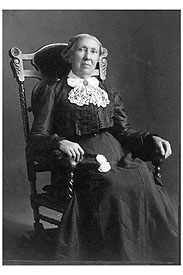 Parley
was assassinated May 13, 1857, near Van Buren, Arkansas, by Hector McLean.
Parley
was assassinated May 13, 1857, near Van Buren, Arkansas, by Hector McLean.
Elenor J. McComb had married Hector McLean and had three children. They were living in San Francisco where they heard the Gospel and Elenor and her two sons were baptized, but Hector did not accept Mormonism and did not want his children to belong to the Mormon Church so he sent them around the Horn to New Orleans to be cared for by Mrs. McLean’s parents. Elenor became acquainted with Parley P. Pratt on one of his missions and divorced her husband, then came to Utah where she was married to Apostle Pratt in Salt Lake City in 1855. Hearing that her children were at her father’s home she made plans to go to New Orleans and gain possession of them. When Elder Pratt was called on a mission she accompanied him and went on to her father’s house where she was united with her children.
Hector McLean blamed Elder Pratt for his estrangement with his former wife, Eleanor. He filed charges against Parley while Parley was in Indian Territory in Oklahoma with Elder George B. Higginson who was working among the Creek and Cherokee Indians. Elder Pratt was arrested and taken to Van Buren, Crawford County, Arkansas. Evidence presented against Elder Pratt was not considered sufficient to warrant holding him, and he was acquitted. The judge did not announce the decision to release him and kept him in the jailhouse overnight hoping to dissuade McLean from his avowed determination to kill him. The next morning the Judge brought Parley his horse, offered him a knife and a pistol as a means of self-defense, but Parley declined saying, “Gentlemen, I do not rely on weapons of that kind, my trust is in my God. Good-bye, gentlemen.”
Hector McLean and two accomplices caught up with Elder Pratt twelve miles northeast of Van Buren (near Alma, Arkansas) in front of the Winn Farm. McLean fired shots at him and then stabbed him in the left breast with his bowie knife and shot him in the neck.
Mr. Winn was a witness to the entire scene. He and some of his neighbors attended to Parley in his dying moments, and were told by him how to notify his family and the disposition of his personal effects. He then bore a firm final testimony of the truthfulness of the Gospel to them and that Joseph Smith was indeed a prophet of the living God, and told them ”I am dying a martyr to the faith.” He was buried in Sterman’s graveyard (now known as Fine Springs).
When news of Parley’s death reached Salt Lake City, the First Presidency came to see his family. President Brigham Young said, referring to Parley’s death. “Nothing has happened so hard to reconcile my mind to since the death of Joseph. Brother Parley has done more good on this short mission than many elders will do in their whole life.”
Young Widow
At the time of Parley’s death, Ann Agatha was only twenty-eight years old. She and Parley had five children: Agatha, born 7 July 1848 (died 12 August1914); Malona, born 15 April 1850 (died 27 Oct. 1913); Marion, born 28 November, 1851 (died 6 October 1852); Moronl, born 10 October 1853 (died 28 June, 1911); and Eveline. born 8 August 1856 (died 16 August 1917).
Ann Agatha was still so young and left with her five young children. Three months after Parley’s death, she was asked by Joseph Harris Ridges, builder of the Tabernacle Organ, to be his wife. By counsel of President Brigham Young, she was married for time to Joseph Ridges, 4 March 1860. Two children were born to them—a daughter, Louise, who died in infancy, and a son, Wilford Owen Ridges.
Mother & Daughter Wives
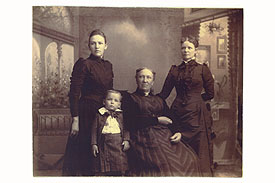 Six
years after Ann Agatha married Joseph
Ridges, Joseph took for his fourth wife, Agatha Pratt, daughter of Ann Agatha
and Parley P. Pratt. About this time Ann Agatha discontinued living with Joseph
Ridges, although there is no record of a divorce.
Six
years after Ann Agatha married Joseph
Ridges, Joseph took for his fourth wife, Agatha Pratt, daughter of Ann Agatha
and Parley P. Pratt. About this time Ann Agatha discontinued living with Joseph
Ridges, although there is no record of a divorce.
(Photo on left: Ann Agatha seated with Agatha Pratt Ridges on the right.)
Church Activity
Ann Agatha was an ardent church worker with a strong testimony of the gospel. Among her many positions in the church, she served as Relief Society president twice. She was a member of the Tabernacle Choir for many years. She was active in the new movement, The Retrenchment Society, in 1870.
In 1890, Ann Agatha moved with her youngest son, Wilford Owen Ridges, to Ogden, Utah (her home was at 3162 Adams Avenue). Two years later, Wilford Owen left for a mission to the Southern States.
Later Life
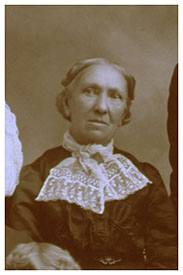 All
who knew Ann Agatha loved and respected her. She worked hard all of her life
and was never known to complain. She came through her hardships and sorrow with
faith, pride, and a sense of humor.
All
who knew Ann Agatha loved and respected her. She worked hard all of her life
and was never known to complain. She came through her hardships and sorrow with
faith, pride, and a sense of humor.
During her last years, she was to a great degree deprived of her sight, but she continued to write and kept herself well posted on current and general events. She kept close contact not only with her children, but also with her grandchildren. She was a kindly person who wanted to give more than to receive. She was a typical pioneer grandmother, one who kept the cookie jar filled. The grandchildren recall that they never went into her home but they were well received.
Dedication of the Temple
Ann Agatha recorded in her journal on March 25, 1893, “A general fast was appointed by the First Presidency to be held throughout the Church today to help bring about a greater unity of feeling among the Saints and make us more worthy to join in the dedicatory services to be held in the Temple (Salt Lake) commencing on April 6, 1893. There was a large attendance at our meetinghouse and a spirit of testimony prevailed.”
Ann
Agatha tells that she went to Salt Lake and stayed two weeks and attended three
of the dedicatory services of the temple. “The grandeur and magnificence of
the Temple is beyond 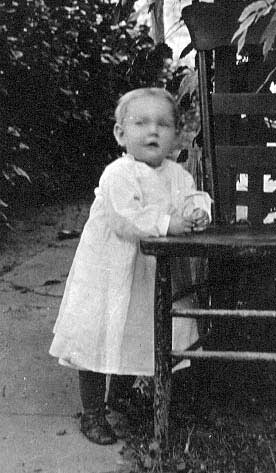 description. The services were most impressive. The prayer
was the most comprehensive one I ever heard. Pres. Woodruff read it at the first
service on the 6th (of April). His voice was full and firm. No one who heard
him would think for a moment that he was 86 years old. His remarks were filled
with inspiration, prophecy and comfort for the Saints of God. I think I never
saw a man so filled with the spirit and power of God as was Joseph F. Smith.
It seemed as though his feet scarcely touched the floor, as If he were very
near translation and the words he spoke melted the hearts of all present”
description. The services were most impressive. The prayer
was the most comprehensive one I ever heard. Pres. Woodruff read it at the first
service on the 6th (of April). His voice was full and firm. No one who heard
him would think for a moment that he was 86 years old. His remarks were filled
with inspiration, prophecy and comfort for the Saints of God. I think I never
saw a man so filled with the spirit and power of God as was Joseph F. Smith.
It seemed as though his feet scarcely touched the floor, as If he were very
near translation and the words he spoke melted the hearts of all present”
Grandma Pratt Sees Infant Charles Dean
On May 5, 1894, Ann Agatha records that she went to Salt Lake City, and among the places she visited was her granddaughter, Florence Dean’s, home. She said, “Went to Florence’s. All well. Her baby Charles (Charles Edwin Dean - photo right) is a noble, lovely boy, all that a mother could wish.”
Death of Ann Agatha
Ann Agatha Walker Pratt died in her home in Ogden, Utah, on June 25, 1908. Her granddaughter, Hazel Pratt Christensen, wrote: “In the spring of 1908 she (Ann Agatha Pratt) fell and hurt her hip She died of yellow jaundice and I would say that this was brought on partly by the accident; at least It didn’t do her any good. She was up and around till perhaps a month before she died; she would have chills and fever.” Even though her eyesight became very dim in her declining years, she could see well enough that she always kept tidy, neat, and clean.
(This history was compiled by Marie Dean Speakman in March 1997, primarily from “Parley P Pratt His Twelve Wives,” compiled by Kate B. Carter, January 1974; and from “The Autobiography of Parley P Pratt.”)